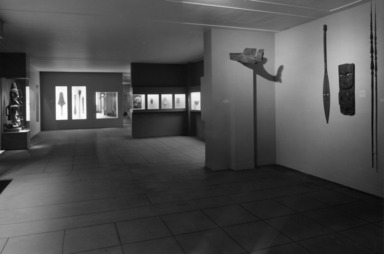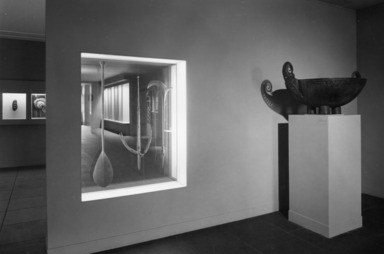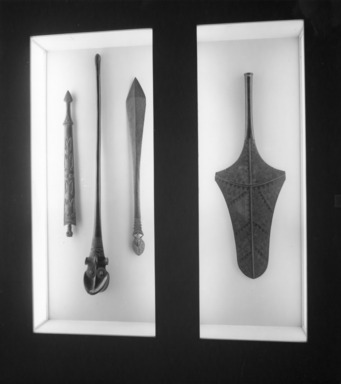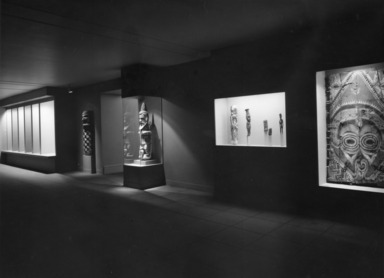

Fellowship Exhibition, Oceanic Gallery, June 01, 1957 through June 30, 1958 (Image: AON_E1957i001.jpg Brooklyn Museum photograph, 1957)

Fellowship Exhibition, Oceanic Gallery, June 01, 1957 through June 30, 1958 (Image: AON_E1957i002.jpg Brooklyn Museum photograph, 1957)

Fellowship Exhibition, Oceanic Gallery, June 01, 1957 through June 30, 1958 (Image: AON_E1957i003.jpg Brooklyn Museum photograph, 1957)

Fellowship Exhibition, Oceanic Gallery, June 01, 1957 through June 30, 1958 (Image: AON_E1957i004.jpg Brooklyn Museum photograph, 1957)

Fellowship Exhibition, Oceanic Gallery, June 01, 1957 through June 30, 1958 (Image: AON_E1957i005.jpg Brooklyn Museum photograph, 1957)
Fellowship Exhibition, Oceanic Gallery
-
September 4, 1957
You are invited to a press opening on Monday, September 16, from 2 to 5 p.m. to preview the following exhibitions:
Art of the South Pacific, opening on September 17. A completely new presentation of the primitive arts of these little known peoples; 95 vigorous pieces probably executed during the past century, including feathered masks, painted wood figures, household utensils and tools, etc. Illustrated catalog. First floor.
Alumni Exhibition, opening on September 17. Oils, watercolors, sculpture, graphics and ceramics by former students of the Brooklyn Museum Art School. Some are shown by invitation, some chosen by juries. The exhibition will remain on view through October 13. First floor.
Photographs are available.
Very Sincerely,
Betty Chamberlain
Community Development Office
Brooklyn Museum Archives. Records of the Department of Public Information. Press releases, 1953 - 1970. 1957, 050.
View Original -
September 15, 1957
More than 95 striking objects from the South Pacific will go on view on September 17, accompanied by an illustrated booklet on the art-in-daily-life customs of these little known primitive peoples. The exhibition has been organized and the booklet written by Miss Jane Powell and Mr. Martin Friedman, who a year ago won Museum Fellowships to the Brooklyn Museum. Their special installation displays work from the Museum Collection and from other museums.
Ancestor worship and the psychological need for symbolic art expression, even in simple household utensils, are the dominating motivations shown in the bold and colorful shields, masks, carved ancestor figures, sacred adzes and war clubs, and bowls, executed over the past century or more. The high rank and respect accorded these artists might well cause envy among today’s Western artists. The greatest of care was exercised by the community to foster the best aesthetic results, the finest craftsmanship and the most effective expressions of local religious and social ideas. There has still not been sufficient research to date these cultural products very accurately. Probably most Oceanic art dates from the past two centuries; however, most objects were made of perishable materials, and those of stone may be of greater antiquity. Today most of the PacIfic cultures no longer produce art; only a few in the most remote areas have remained relatively intact from the incursions of Western civilization.
Pacific Islands culture divides into three areas: Melanesia, Polynesia and Micronesia.
Melanesian art (New Guinea, Admiralty Islands, Solomon Islands, Fiji Islands, New Caledonia, New Hebrides, New Britain, New Ireland, etc.) tends toward expressionism, distortion, exaggeration, usually in dynamic form. A particularly striking mask with huge fiber head-dress comes from New Ireland; it was for use in important funeral ceremonies. Another mask, from New Britain, was made by modeling paste over the actual skull of an ancestor or a captive. A brightly painted mortuary board from New Guinea was the residence of supernatural spirits, while a ceremonial shield was carved with numerous eyes for protection. These pieces are perhaps particularly related to Expressionism as developed in Germany in our own time.
Polynesian art (Tonga, Samoa, Cook Islands, Marquesas Islands, New Zealand, Easter Island, etc.) is generally more decorative, more ordered and abstract. Geometric design frequently forms surface decoration, and less emphasis on the human content appears. Elegantly carved war clubs were not only useful but also showed rank and prestige and were carried as proof of this, like the Englishman and his umbrella. They were made of wood or bone; handsome examples are shown from the Marquesas and from the Maori of New Zealand. From the Cook Islands comes a delicately fashioned adze, made as the sacred dwelling of the god of woodcarvers and carpenters. When figures do appear from this area, they are not intended as mirror images but rather as symbolic representations of ancestors. One ancestor figure from Easter Island is portrayed as a cadaver, hollow-cheeked and drooping in figure. Another, a Maori figure, is covered with designs simulating the tattoos on some specific person.
In Micronesian art (Gilbert Islands, Ladrone Islands, etc.), the objects made are usually useful ones. This art is closer to the Polynesian than to the Melanesian in its basic simplicity and refinement of craftsmanship. A coconut wood sword from the Gilbert Islands is utterly simple and direct in form, yet is elegant - and at the same time devastating - in its overall application of sharks’ teeth.
Brooklyn Museum Archives. Records of the Department of Public Information. Press releases, 1953 - 1970. 1957, 051-52.
View Original

